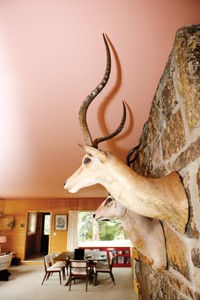"6 Hermosos y bravos toros," says the original bullfight poster for a fund-raiser in Malaga in southern Spain. "Six beautiful and brave bulls." The year was 1959 and the framed poster is on the wall of the master bedroom in the final home of Ernest Hemingway.
Two years later, Hemingway would die from a self-inflicted gunshot wound in this Ketchum home overlooking the Big Wood River in country he loved. The death of the Nobel prize-winning author was reportedly brought on by a fatal case of writer's block perhaps exacerbated by shock treatments given for depression.
Although he only spent an estimated three to eight months in the home over the two years he and his wife, Mary, owned it before his death, it's part of the legacy and the legend of the man. The Nature Conservancy of Idaho, which owns the property, is engaged in ongoing work to document the authenticity of its items. A grant from Zions Bank got that work started last year.
A recent donation of $26,200 from the Boise-based Hemingway House Foundation will go toward the home's restoration. With the vision of preserving the home continuing under the aegis of the conservancy, the Hemingway House Foundation dissolved and passed its resources to the conservancy.
The 1950s-era home contains a veritable trove of stuff. His wooden snowshoes from Vermont with boots in them lean against a fireplace. African trophy heads are mounted on the walls; he went on an African safari during the last two years of his life. There are photos of the Hemingways in Spain and photo I.D. documents. There is a table inlaid with Spanish tiles depicting bullfighting scenes and much more.
Taylor Paslay looks after the home for The Nature Conservancy shooing errant, curious tourists away from the home, which is on a private road. Another reason the Hemingway House Foundation dissolved was the opposition from neighbors to public tours of the home. But part of Paslay's other duties include photographing and cataloguing items and working to figure out what's what. The conservancy took over the home after Mary Hemingway's death in 1986.
But which items are authentic and intrinsic to the story of the man and what are just things?
"Part of the difficulty with the house is what stuff is important as far as the Hemingway legacy is concerned," Paslay said.
They know the Malaga poster is the real deal but don't know about other items in the three-level home and they are working to find out, said Paslay.
Hemingway scholar Marty Peterson of Boise agrees there are special challenges to honing in on what's important in the home.
"One of the problems with the Hemingway home is you have multiple layers of occupancy in the house," he said.
It was sold furnished to the Hemingways in the late 1950s by Dan Topping, the late part owner of the New York Yankees.
The home looks like wood but was built of cement poured into wooden forms with the same process used to build the Sun Valley Lodge. It was very much a hunting lodge when Topping built it.
"They would have hunted ducks off the deck," Paslay said, adding he still finds remnants of clay pigeons on the grounds.
The Hemingways brought items from their home in Cuba to the Ketchum home and purchased items locally in Ketchum, Peterson said. Mary Hemingway continued to live there for 25 years, and she accumulated items. After she left the home to The Nature Conservancy, more things were added when the organization once had its office there, he said. Many original Hemingway possessions, such as letters and documents, ended up at the Kennedy Library in Boston.
Paslay started his inventory work last summer. "My goal is to have it all wrapped up this summer."
He took a rolled-up painting and flattened it on the large dining room table. It is a painting of Hemingway done on canvas. It says: "Ernest Hemingway Mister Papa" and it's dated 1959.
"We're trying to find out exactly what it is," said Paslay.
Hemingway's love of the land here, which reportedly reminded him of Spain, extended beyond Ketchum.
"He loved this valley, the south valley—Silver Creek," Paslay said. It was along Silver Creek where Hemingway fished and hunted with his friends and locals. "The whole preserve (Silver Creek Preserve owned by The Nature Conservancy) really started out of the house ... Hemingway's love for the valley—we're trying to protect that."
The home is not only important to the Hemingway connection to Ketchum and Sun Valley. It's also an icon for the conservancy.
"This is where The Nature Conservancy started out in Idaho," Paslay said.


 The 1950s?era Hemingway home in Ketchum contains numerous items that could be historically important to the writer and his legacy. Photo by Chris Pilaro
The 1950s?era Hemingway home in Ketchum contains numerous items that could be historically important to the writer and his legacy. Photo by Chris Pilaro



































